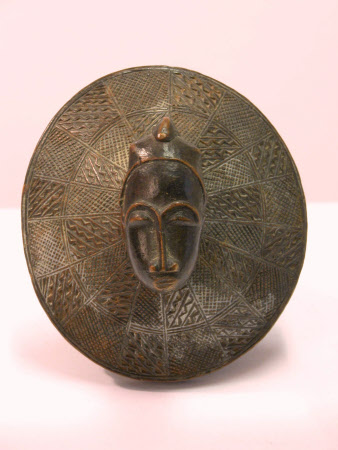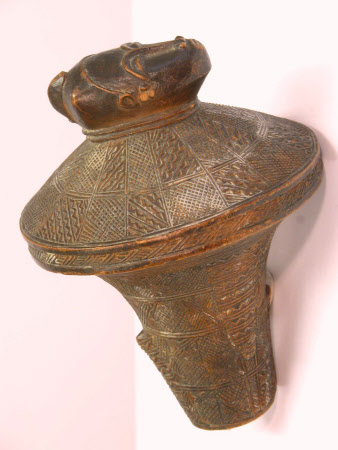A flywhisk or staff handle
Baule artist
Category
Art / Sculpture
Date
Unknown
Materials
Wood
Measurements
120 mm (Height) x 85 mm (Depth)
Place of origin
Republic of Côte d'Ivoire
Order this imageCollection
Greenway, Devon
NT 120526.1
Caption
This small, delicately carved object was made by an artist of the Baule people in Côte d’Ivoire and served as the top of a staff handle or fly-whisk for use by a chieftain or a high-ranking member of the community. The Baule live in an egalitarian agricultural society in the eastern region of Côte d’Ivoire and also in Ghana, and their social and political institutions are guided by matrilineal descent. The carving shares the characteristics of a Baule sculptural mask, displaying an introspective face and wearing a headdress surrounded by fine Akan geometric designs. If employed as a fly-whisk handle, it would have held long animal hairs that could be swished through the air to discourage insects, and as a prestige object it would also have served an important ceremonial function, conveying the authority and status of its user. It is part of a collection of carved African figures that belonged to Max Mallowan (1904–78) – the second husband of the writer Agatha Christie (1890–1976) – who may have acquired them while serving in North Africa during the Second World War.
Summary
Wood, a dignitary's flywhisk or staff handle, Baule artist,unknown date. An intricately carved Baule dignitary's flywhisk or staff handle, with shield-shaped knob and tapering stem finely incised with geometric patterns, the knob with a central mask carved in high relief. Mounted on a metal bracket and square wood base.
Full description
This delicately carved flywhisk handle, or finial for a prestige staff, was made by a Baule artist. Baule artists from Côte d’Ivoire or Ghana have widely sought-after skills, and flywhisks would have been carved for use by Baule chiefs as well as made for neighbouring communities as trade items. Baule sculptural forms serve as the intermediary to the spirit world and speak to the prestige of the holder, enhancing their public standing during ceremonies. Features include: elongated necks, suggesting a moral person with the esteem of others; raised scarification on the face reflecting ideas of a socialised and refined human being; elaborate hairstyles symbolising beauty and drawing attention to the head. The face represented on top of this Baule handle is reminiscent of other Baule masking forms and has a clear lustrous face with a high forehead, large downcast eyes, and an imaginative ornament above the head, the seat of freedom and intelligence (see Vogel 1997: 236). The handle is also covered in fine-line geometric patterns typical of Akan designs.
Makers and roles
Baule artist, sculptor
References
Vogel 1997: Susan Mullin Vogel, Baule: African Art, Western Eyes, (London, 1997)

